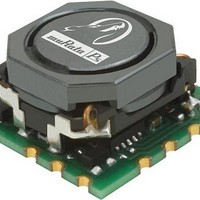OKL-T/6-W5P-C Murata Power Solutions Inc, OKL-T/6-W5P-C Datasheet - Page 16

OKL-T/6-W5P-C
Manufacturer Part Number
OKL-T/6-W5P-C
Description
DC/DC Converters & Regulators 5Vin 0.6-3.3Vout 6A 19.8W Pos Polarity
Manufacturer
Murata Power Solutions Inc
Datasheet
1.OKL-T6-W5N-C.pdf
(18 pages)
Specifications of OKL-T/6-W5P-C
Output Power
19.8 W
Input Voltage Range
2.4 V to 5.5 V
Input Voltage (nominal)
5 V
Number Of Outputs
1
Package / Case Size
12.2 mm x 12.2 mm x7.2 mm
Output Voltage
0.6 V to 3.3 V
Product
Non-Isolated / POL
Lead Free Status / RoHS Status
Lead free / RoHS Compliant
Output Current Limiting
Current limiting inception is defi ned as the point at which full power falls
below the rated tolerance. See the Performance/Functional Specifi ca-
tions. Note particularly that the output current may briefl y rise above its
rated value in normal operation as long as the average output power is
not exceeded. This enhances reliability and continued operation of your
application. If the output current is too high, the converter will enter the
short circuit condition.
Output Short Circuit Condition
When a converter is in current-limit mode, the output voltage will drop as
the output current demand increases. If the output voltage drops too low
(approximately 98% of nominal output voltage for most models), the mag-
netically coupled voltage used to develop PWM bias voltage will also drop,
thereby shutting down the PWM controller. Following a time-out period, the
PWM will restart, causing the output voltage to begin rising to its appropri-
ate value. If the short-circuit condition persists, another shutdown cycle
will initiate. This rapid on/off cycling is called “hiccup mode”. The hiccup
cycling reduces the average output current, thereby preventing excessive
internal temperatures and/or component damage.
because you do not have to power down the converter to make it restart.
The system will automatically restore operation as soon as the short circuit
condition is removed.
Remote On/Off Control
The OKL Series power modules can be specifi ed with either a positive or nega-
tive logic polarity. See Figures 7 and 8 for On/Off circuit control. In the positive
logic on/off option the unit turns on during a logic high on the On/Off pin and
turns off during a logic low. In a negative logic on/off option, the unit turns off
during logic high and on during logic low. The On/Off signal should always be
reference to ground. For positive or negative option, leaving then On/Off pin
disconnected will turn the unit on when input voltage is present.
high to +Vin. The On/Off circuit control is shown in fi gure 7. When the
external transistor Q1 is in the off state, the internal PWM enable pin is pull
high causing the unit to turn on. When Q1 is turn on, the On/Off pin is pulled
low and the units is off. Rp should be around 20K ohms.
within a low voltage (see specifi cations) with respect to –Vin. The unit is off
when the ON/Off is pulled high with respect to –Vin (see specifi cations). The
On/Off circuitry is shown in fi gure 8. The On/Off pin should be pulled high
with an external pull-up resistor (20K ohms). When Q1 is in the off state,
the On/Off pin is pulled high, transistor Q3 is turn on and the unit is off. To
turn on the unit, Q1 is turn on, pulling the On/Off pin low and turning Q3 off
resulting on the unit being on.
fi ed signal current when brought low and withstand appropriate voltage
when brought high. Be aware too that there is a fi nite time in milliseconds
(see specifi cations) between the time of On/Off Control activation and
stable, regulated output. This time will vary slightly with output load type
and current and input conditions.
The “hiccup” system differs from older latching short circuit systems
Positive—Units are enabled when the on/off pin is left open or is pulled
Negative—Units are enabled when the ON/Off is open or brought to
Dynamic control of the On/Off function should be able to sink the speci-
www.murata-ps.com
Output Capacitive Load
These converters do not require external capacitance added to achieve
rated specifi cations. Users should only consider adding capacitance to
reduce switching noise and/or to handle spike current load steps. Install
only enough capacitance to achieve noise objectives. Excess external
capacitance may cause regulation problems, degraded transient response
and possible oscillation or instability.
GND
+Vin
GND
+Vin
Rp
Q1
Rp
Q1
Figure 7. On/Off Circuit Control for Using Negative On/Off Logic
Programmable Output 6-Amp iLGA SMT PoLs
Figure 6. On/Off Circuit Control for Using Positive On/Off Logic
GND
+Vin
09 May 2011 MDC_OKL-T/6-W5 Series.A08 Page 16 of 18
On/Off
GND
+Vin
On/Off
OKL N Module
BOM
BOM
OKL-T/6-W5 Series
OKL P Module
BOM
BOM
Rp
Q1
Rp
Q1
20K
Q SMT MOS P 30V
R1
20K
Q SMT MOS P 30V
email: sales@murata-ps.com
Q3
E
E
PWM
PWM
GND




















